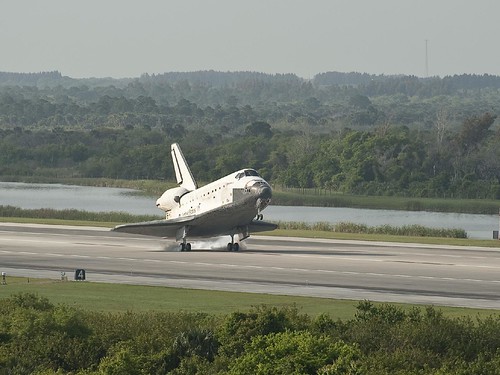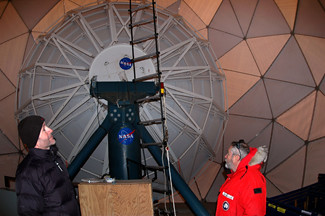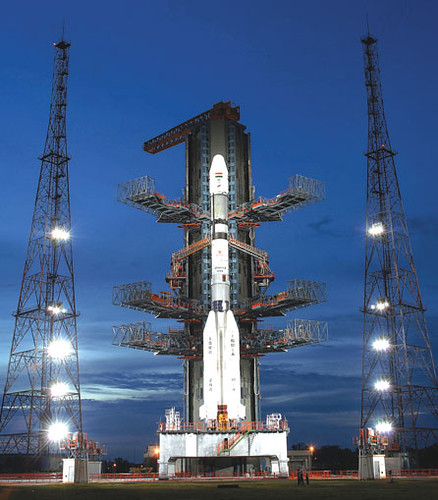South Africa, Brazil, and India agree to joint satellite programme at trilateral summit.
[EngineeringNews.co.za – 04/16/2010]
KVH debuts CG-5100 Inertial Measurement Unit (IMU) solution well-suited for applications already having GPS but needing full IMU capability.
[SatNews – 04/15/2010]
India’s cryogenic rocket satellite launch fails after apparent successful take-off as control of the cryogenic rocket motors fails.
[BBC News – 04/15/2010]
EUMETSAT’s Meteosat-9 meteorological satellite observes ash from volcanic eruption in Iceland.
[SatNews – 04/15/2010]
NOAA’s GOES-13 satellite renamed GOES-EAST, residing at prime orbital slot to observe potentially life-threatening weather along Eastern U.S., Atlantic Ocean, and Gulf of Mexico.
[SatNews – 04/15/2010]
U.S. Marine Corps networking plans driven by tactical, satellite based technologies.
[Signal Online – 04/15/2010]
Vizada, with Inmarsat, to launch test program to validate readiness of Inmarsat’s IsatPhone Pro for market.
[SatNews – 04/15/2010]
Stratos gets advance orders for 1,000 of Inmarsat’s new handheld IsatPhone Pro.
[Satellite Spotlight – 04/15/2010]
RapidEye enters contract with Metria of Sweden for Metria to be distributor of RapidEye satellite imagery in the Scandinavian, Baltic, and Icelandic data markets.
[SatNews – 04/15/2010]
Vizada launches SkyFile Video powered by ClipWay application, software that can be downloaded and installed on any computer and used to send video images over a mobile satellite terminal.
[SatNews – 04/15/2010]
Russian Deputy Prime Minister Sergei Ivanov confirms plans to launch a Soyuz carrier rocket from the Kourou space center in French Guiana later this year.
[Space Daily – 04/14/2010]
Intelsat expands African satellite infrastructure and is offering new satellite capacity to the region on Intelsat 25 and Intelsat New Dawn.
[Satellite Spotlight – 04/14/2010]
Lockheed Martin completes work on first U.S. Air Force advanced EHF satellite, readying it for Mid-2010 launch.
[PR Newswire – 04/14/2010]
PSSI and Ericsson provide technology and satellite transmission services enabling NASCAR Media Group to provide multiple streams of live HD content from races to its 75 million fans.
[SatNews – 04/14/2010]
Intelsat launches IntelsatONE, a global, terrestrial architecture consisting of an IP/MPLS-based network, fiber, teleports, and points of presence powered by Cisco Systems.
[Satellite Today – 04/14/2010]
Nagravision and SkyLife of South Korea expand their relationship to collaborate on 3D television.
[SatNews – 04/14/2010]
Eutelsat teams with Russia’s General Satellite Corporation and the Marinsky Theatre for April 15th 3D TVsatellite transmission of classical ballet performed by leading Russian dancers.
[SatNews – 04/14/2010]
Newtec introduces at NAB its DualFlow technology that allows users to easily migrate to satellite IP-based operations by interfacing modems with networks using either ASI or IP, or both at once.
[SatNews – 04/14/2010]
CPI introduces enhanced version of its Ku-band High Power SSPB, a fully integrated unit that is one of the lightest and smallest on the market.
[SatNews – 04/14/2010]
Ericcson signs 3D TV, HD deals with ESPN, Tata Sky.
[Satellite Today – 04/14/2010]
Move by FCC under its National Broadband Plan (NBBP) to release 500 MHz of additional spectrum for broadband service applauded by satellite operators Harbinger and Globalstar, opposed by Verizon and AT&T.
[Fierce Broadband Wireless – 04/14/2010]
Increasing demand for bandwidth coupled with finite limit of available orbital slots drives wider acceptance among satellite operators of dual-use satellite platforms.
[PR Newswire – 04/14/2010]
Raytheon successfully completes major communications upgrade in Antarctica for the National Polar-orbiting Operational Environmental Satellite System (NPOESS) program.
[Space Daily – 04/14/2010]
ESA’s CryoSat-2, launched April 8, has had excellent performance, delivering its first data just hours after ground controllers switched on the satellite’s sophisticated radar instrument for the first time.
[esa news – 04/13/2010
Globecomm Systems launches at NAB their Tempo Enterprise Media Platform, a hosted terrestrial service allows enterprises with a single platform to deliver interactive training, employee communications, and digital display to global audiences.
[SatNews – 04/13/2010]
Ethiopa’s national telecom operator, ETC, chooses Gilat for backhaul solution to extend range of cellular services to remote regions.
[Market Watch – 04/13/2010]
NASA – Chrysler agreement seeks to use technologies originally developed for human spaceflight to enhance future vehicles, and adapt advanced automotive technology for use in space.
[SatNews – 04/13/2010]
VELOCITY Broadcasting of Pittsburgh, PA, becomes largest global, private HD broadcasting network through agreement with Global Vision Networks, expanding throuigh satellite distribution to more than 200 network sites across 3 continents.
[SatNews – 04/13/2010]
Goodrich Corporation continues its celebration of 50 years of working in advanced space programs at the National Space Symposium in Colorado Springs, CO.
[SatNews – 04/13/2010]
Xicom Technology announces at NAB new lightweight, high power, antenna-mounted traveling wave tube amplifiers to expand capabilities of broadcasters and teleport operators.
[SatNews – 04/13/2010]
Raytheon successfully completes major satellite communications system upgrade in Antartica for the National Polar-orbiting Operational Satellite System program, providing better performance and higher data rates.
[PR Newswire – 04/13/2010]
ACS Angola contracts with Eutelsat for capacity on W7 to expand satellite resources to support high growth of data communications in the region.
[PR Newswire – 04/13/2010]
EchoStar Satellite Services announces that Minnesota-based Pace International has joined its VIP-TV Reseller Program.
[SatNews – 04/13/2010]
SES WORLDSKIES signs long-term multi-transponder deal with Puerto Rico Telephone to deliver its CLARO TV DTH offering to homes across Puerto Rico.
[SatNews – 04/13/2010]
GSA and CISA lay out their strategy under their joint Future Commercial Satellite Communications Acquisition (FCSA) program, with draft request for proposals for $3.5 billion in commercial satellite services between 2011 and 2015.
[Defense Systems – 04/12/2010]
India charges that Chinese anti-satellite program is a global threat.
[Space Daily – 04/12/2010]
GlobeCast signs contract with Argentine broadcaster Pramer allowing Pramer to base its playout and origination facilities at GlobeCast’s Sunrise, Florida technical operations center.
[SatNews – 04/12/2010]
Integral Systems announces on-schedule handover of satellite bus operations for the third Wideband Global SATCOM Space Vehicle to the Command and Control System – Consolidated baseline.
[Market Watch – 04/12/2010]
While other industries were slammed by recession, the global space business grew 7% in 2009 over 2008, to $261 billion, and 40% over the past 5 years.
[Reuters – 04/12/2010]
DG FastChannel and Univision partner to provide High Definition commercial content during broadcast of 2010 FIFA World Cup, which is expected to be viewed by up to 95% of U.S. Hispanic households.
[Market Watch – 04/12/2010]
Russia had no part in the Indian cryogenic engine program according to the Indian Space Research Organisation (ISRO).
[Space Daily – 04/12/2010]
NASA engineers at Goddard Space Flight Center find and patent a way to improve reception of GPS signals.
[Space Daily – 04/12/2010]
China aims to capture 20% of the world’s space business by 2015, according to the country’s only satellite launch contractor.
[Space Daily – 04/12/2010]
Avanti sells new capacity and services on its first satellite, HYLAS 1, to longstanding partner in Eastern Europe MPB.
[SatNews – 04/12/2010]
TeleCommunication Systems receives additional $7.1 million in revenue from U.S. Army for maintenance of internet and satellite-based communications systems deployed outside the country.
[Baltimore Sun – 04/10/5010]
NSR releases report "Hosted Payloads on Commercial Satellites," the "first ever" market study which analyzes and quantifies the business case for hosted payloads, covering the entire gamut of the satellite industry.
[NSR – April, 2010]
NSR states that "Broadband Satellite Markets Did Not Falter in Face of 2009 Economic Crisis – Sector Revenues to Increase by 135% in Coming Ten Years."
[NSR – April, 2010]
WBMSAT PS services











